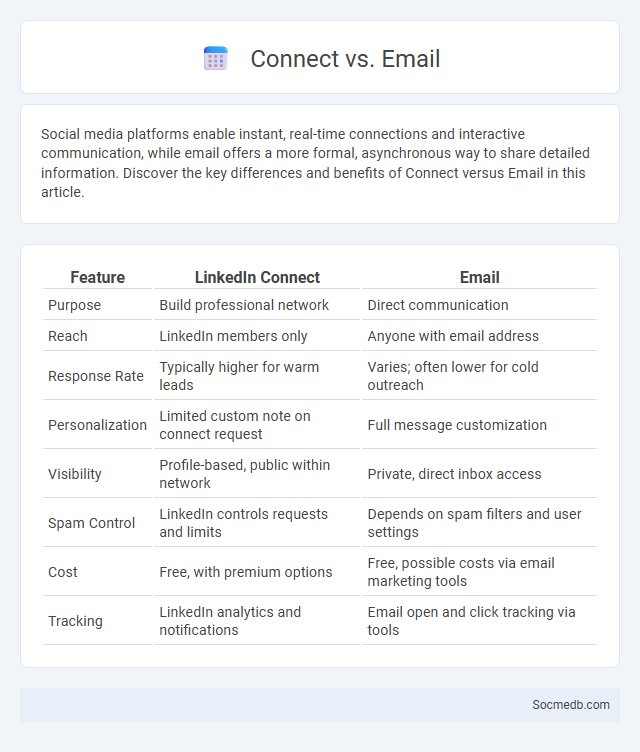
Photo illustration: Connect vs Email
Social media platforms enable instant, real-time connections and interactive communication, while email offers a more formal, asynchronous way to share detailed information. Discover the key differences and benefits of Connect versus Email in this article.
Table of Comparison
| Feature | LinkedIn Connect | |
|---|---|---|
| Purpose | Build professional network | Direct communication |
| Reach | LinkedIn members only | Anyone with email address |
| Response Rate | Typically higher for warm leads | Varies; often lower for cold outreach |
| Personalization | Limited custom note on connect request | Full message customization |
| Visibility | Profile-based, public within network | Private, direct inbox access |
| Spam Control | LinkedIn controls requests and limits | Depends on spam filters and user settings |
| Cost | Free, with premium options | Free, possible costs via email marketing tools |
| Tracking | LinkedIn analytics and notifications | Email open and click tracking via tools |
Introduction to Professional Networking Methods
Professional networking methods on social media platforms such as LinkedIn, Twitter, and industry-specific forums enable you to connect with key influencers, potential employers, and peers in your field. Leveraging features like personalized connection requests, engaging content sharing, and participating in relevant group discussions increases your visibility and credibility within your professional community. Targeted networking on these platforms helps you build meaningful relationships, discover new opportunities, and advance your career strategically.
Overview of Connect, Email, and Connection Request
Connect is a social media feature that facilitates direct interaction by allowing users to establish relationships quickly. Email integration enhances communication by enabling messages to be sent and received within the platform, ensuring seamless correspondence. Connection requests function as invitations to network, providing a controlled method for users to expand their professional or personal circles.
Purpose and Context for Each Approach
Social media platforms serve distinct purposes and require tailored strategies to maximize engagement and reach. Instagram excels in visual storytelling ideal for brand awareness, while LinkedIn focuses on professional networking and B2B marketing. Crafting content that aligns with each platform's unique audience behavior and context enhances effectiveness and drives targeted results.
Key Differences Between Connect, Email, and Connection Request
Social media platforms differentiate between actions such as Connect, Email, and Connection Request based on purpose and privacy levels. A Connect action typically allows immediate acceptance and networking, while Email serves as a direct, personal communication channel often used for detailed messaging. Connection Requests require approval before establishing a link, ensuring controlled access to professional or personal networks.
Pros and Cons of Sending a Connect Request
Sending a connect request on social media enhances your professional network, providing access to valuable opportunities and diverse perspectives. However, it may also expose you to unsolicited messages or compromise your privacy if sent indiscriminately. You should strategically evaluate each request to maximize benefits while minimizing potential risks.
Advantages and Disadvantages of Using Email
Email enables fast, cost-effective communication, enhancing productivity and maintaining professional connections worldwide. However, excessive emails can lead to information overload, reducing efficiency and increasing stress levels. Security risks, such as phishing and spam, pose threats to sensitive data and require vigilant management.
When to Use a Direct Connection Request
When sending a direct connection request on social media, it's most effective to reach out after meaningful interaction, such as commenting on a post or engaging in a conversation. You should use this approach when you have a clear reason to connect, like shared professional interests or mutual goals, ensuring your request feels personalized and relevant. Timing your request appropriately increases the likelihood of acceptance and helps build genuine relationships.
Best Practices for Effective Outreach
Effective social media outreach requires consistent, authentic engagement tailored to your target audience's preferences and behaviors. Leveraging high-quality visuals, clear calls-to-action, and timely responses enhances user interaction and builds trust. Analyzing platform metrics regularly allows you to refine your strategy, ensuring your content resonates and drives meaningful connections.
Choosing the Right Method for Your Goals
Selecting the right social media platform and strategy depends heavily on your specific business objectives, whether driving brand awareness, increasing engagement, or boosting sales. Analyzing audience demographics, platform features, and content formats helps tailor campaigns for maximum impact. Leveraging tools like Instagram for visual storytelling, LinkedIn for B2B networking, or TikTok for viral reach optimizes goal achievement efficiently.
Conclusion: Maximizing Networking Success
Maximizing networking success on social media requires strategic engagement, consistent content sharing, and authentic interaction tailored to your target audience. You can expand your professional connections by leveraging platform algorithms and utilizing advanced search features to identify relevant contacts. Maintaining an active presence and providing value increases visibility and fosters meaningful relationships that drive long-term opportunities.
 socmedb.com
socmedb.com